
The Enchanting Franconian Switzerland: Germany's Hidden Gem
Discover Franconian Switzerland: A Bavarian wonderland of scenic trails, medieval castles, and rich cultural heritage, perfect for nature lovers and history enthusiasts.
Nestled in the heart of Bavaria, Franconian Switzerland is a picturesque region that captivates travelers with its rolling hills, dramatic rock formations, and charming medieval villages. This enchanting destination is renowned for its unique blend of natural beauty and cultural heritage, making it a must-visit for nature enthusiasts and history buffs alike. Explore the region's extensive network of hiking and cycling trails, which meander through lush forests, past ancient castles, and alongside serene rivers. The area is also famous for its impressive limestone caves, such as the Devil's Cave (Teufelshöhle), offering a glimpse into the region's geological wonders. For the more adventurous, the climbing opportunities on the towering rock faces are unparalleled. Franconian Switzerland is also steeped in history and tradition. Wander through the cobblestone streets of idyllic villages like Pottenstein and Gößweinstein, where time seems to stand still. Don't miss visiting the majestic Gößweinstein Castle and the beautiful Basilica of the Holy Trinity. The region is also known for its local breweries, offering a taste of some of the finest Franconian beers. Enjoying a hearty meal in one of the many traditional inns, featuring local specialties such as Schäuferla (roast pork shoulder) and Kloß (potato dumplings), is an experience not to be missed.
Local tips in Franconian Switzerland
- Visit in spring or autumn for the best weather and fewer crowds.
- Wear comfortable hiking shoes to fully enjoy the extensive trail network.
- Try the local beers at a traditional brewery for an authentic experience.
- Check opening times of attractions like Gößweinstein Castle as they can vary seasonally.
- Pack a picnic to enjoy the scenic viewpoints along the hiking routes.
The Enchanting Franconian Switzerland: Germany's Hidden Gem
Nestled in the heart of Bavaria, Franconian Switzerland is a picturesque region that captivates travelers with its rolling hills, dramatic rock formations, and charming medieval villages. This enchanting destination is renowned for its unique blend of natural beauty and cultural heritage, making it a must-visit for nature enthusiasts and history buffs alike. Explore the region's extensive network of hiking and cycling trails, which meander through lush forests, past ancient castles, and alongside serene rivers. The area is also famous for its impressive limestone caves, such as the Devil's Cave (Teufelshöhle), offering a glimpse into the region's geological wonders. For the more adventurous, the climbing opportunities on the towering rock faces are unparalleled. Franconian Switzerland is also steeped in history and tradition. Wander through the cobblestone streets of idyllic villages like Pottenstein and Gößweinstein, where time seems to stand still. Don't miss visiting the majestic Gößweinstein Castle and the beautiful Basilica of the Holy Trinity. The region is also known for its local breweries, offering a taste of some of the finest Franconian beers. Enjoying a hearty meal in one of the many traditional inns, featuring local specialties such as Schäuferla (roast pork shoulder) and Kloß (potato dumplings), is an experience not to be missed.
When is the best time to go to Franconian Switzerland?
Iconic landmarks you can’t miss
Neideck Castle
Discover the historic charm of Neideck Castle, a breathtaking ruin nestled in the scenic Franconian Switzerland, perfect for hiking and exploration.
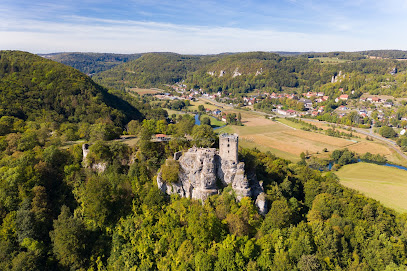
Höhlenruine Riesenburg
Uncover the beauty and history of Höhlenruine Riesenburg, a stunning scenic spot in Franconian Switzerland, perfect for nature lovers and history enthusiasts.

Burgruine Leienfels
Explore the breathtaking Burgruine Leienfels, a historical landmark in Pottenstein perfect for hiking and soaking in stunning views.

Quackenschloss Cave
Explore the stunning Quackenschloss Cave, a natural wonder in Wiesenttal, offering breathtaking rock formations and scenic hiking trails.

Naturpark Fränkische Schweiz - Veldensteiner Forst
Discover the scenic wonders of Naturpark Fränkische Schweiz - Veldensteiner Forst, a paradise for hikers and nature lovers in the heart of Bavaria.

Unmissable attractions to see
Kristall Palm Beach
Discover the perfect blend of adventure and relaxation at Kristall Palm Beach, Stein's premier water park and spa destination for tourists.

Devil's Cave
Discover the enchanting Devil's Cave in Pottenstein, where stunning limestone formations and rich folklore await your exploration.

Pottenstein Castle
Discover Pottenstein Castle: A medieval gem in Bavaria offering rich history, stunning architecture, and breathtaking views of the Franconian landscape.
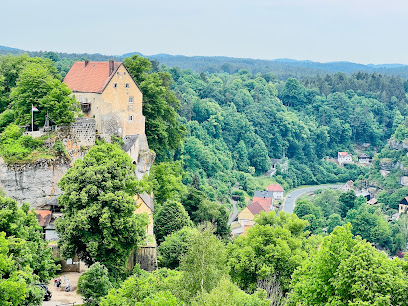
Neideck Castle
Discover the enchanting Neideck Castle in Franconian Switzerland, where history meets stunning vistas and outdoor adventure awaits.
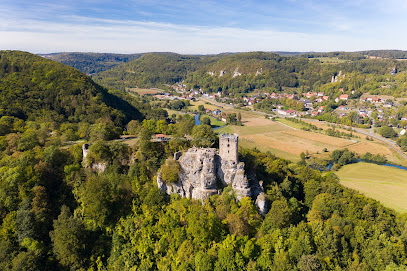
Bing Cave
Explore Bing Cave in Wiesenttal, a stunning natural attraction featuring captivating rock formations and an enchanting underground river.

Schloss Greifenstein
Experience the blend of history and natural beauty at Schloss Greifenstein, a captivating castle in Heiligenstadt, offering scenic hikes and rich heritage.

Höhlenruine Riesenburg
Explore the ancient Höhlenruine Riesenburg, a captivating cave fortress offering breathtaking views and a journey into history in Fränkische Schweiz.

Maximilian Fountain
Explore the stunning Maximilian Fountain in Bamberg, a historical landmark that showcases the city's rich cultural heritage and Bavarian charm.

Streitburg Castle
Experience the enchanting blend of history and nature at Streitburg Castle in Wiesenttal, a perfect destination for adventurous tourists.

Maximiliansplatz
Discover the enchanting Maximiliansplatz in Bamberg, a historical landmark that beautifully blends the past with a vibrant present.

Oswaldhöhle
Explore the breathtaking Oswaldhöhle in Wiesenttal, a hidden gem for hiking enthusiasts, offering stunning trails and captivating natural wonders.

Burgruine Leienfels
Explore the majestic Burgruine Leienfels, a historic ruin in Pottenstein, surrounded by breathtaking hiking trails and rich medieval heritage.

Kirche St. Klara
Immerse yourself in the beauty of Kirche St. Klara, a stunning Gothic Catholic church in Nuremberg, featuring exquisite stained glass and peaceful ambiance.

Quackenschloss Cave
Explore Quackenschloss Cave in Wiesenttal, a stunning tourist attraction with breathtaking rock formations and serene hiking trails.

Wolfsberg Castle
Discover the enchanting Wolfsberg Castle: a historical landmark and hiking paradise nestled in the heart of Bavaria's stunning landscapes.

Essential places to dine
Ratskeller München
Discover authentic Bavarian cuisine at Ratskeller München, where tradition meets flavor in the heart of Munich.
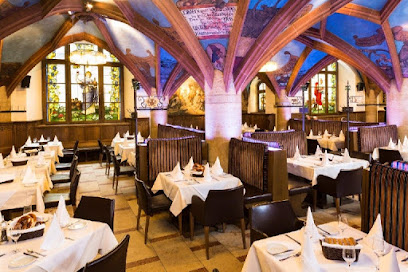
Sternen Grill + Sternen Grill Restaurant im oberen Stock
Experience authentic Swiss cuisine at Sternen Grill in Zurich - a must-visit for every food lover.

Hotel & Restaurant Reichsküchenmeister - Das Herz von Rothenburg
Experience authentic Franconian hospitality at Hotel & Restaurant Reichsküchenmeister in Rothenburg ob der Tauber – your gateway to medieval charm.

Brauhaus am Kreuzberg
Discover the heart of Franconian culinary traditions at Brauhaus am Kreuzberg's vibrant beer garden in Hallerndorf.

seeRestaurant EIBSEE Pavillon
Experience exquisite dining at EIBSEE Pavillon with breathtaking views of Eibsee Lake and the Bavarian Alps.
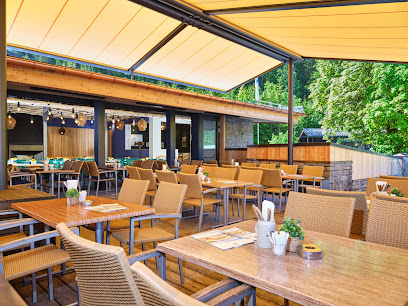
Burg Rabenstein
Experience the charm of Burg Rabenstein: a historic castle offering exquisite Franconian cuisine and vibrant cultural events in stunning surroundings.

Laufen Castle at the Rheinfalls
Experience history and nature at Laufen Castle near Rhine Falls – where Swiss charm meets breathtaking views.

Kaiserschmarrn-Alm
Discover Kaiserschmarrn-Alm: where authentic Bavarian cuisine meets breathtaking alpine views for an unforgettable dining experience.
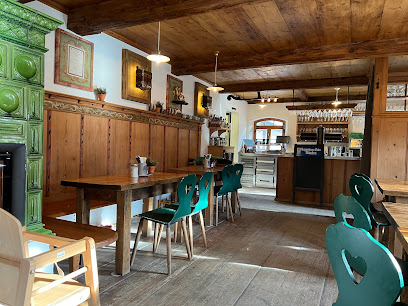
Albrecht-Dürer-Stube
Savor traditional Franconian and Bavarian dishes at Albrecht-Dürer-Stube in Nuremberg—where culture meets culinary delight.

Bocksbeutel-Stube im Hotel Pillhofer
Experience authentic Franconian cuisine at Bocksbeutel-Stube in Nuremberg's charming beer garden and enjoy fine local wines.

Weisses Lamm
Discover Weisses Lamm: A charming restaurant and inn in Engelthal offering authentic Franconian cuisine amid stunning landscapes.

Waldrestaurant Schiesshaus
Discover authentic Franconian cuisine amidst nature at Waldrestaurant Schiesshaus in Nuremberg – an unforgettable dining experience.

Schlehenmühle Inn
Experience authentic Franconian cuisine at Schlehenmühle Inn in Egloffstein - where tradition meets tranquility.

Wirtshaus Frankenstube
Discover Wirtshaus Frankenstube: A charming German restaurant offering authentic Franconian cuisine and an inviting beer garden experience.

Landgasthaus Ziegelscheune
Discover authentic German cuisine at Landgasthaus Ziegelscheune in Bad Schandau—where tradition meets taste amidst stunning landscapes.

Markets, malls and hidden boutiques
Centro Oberhausen
Discover Centro Oberhausen, a premier shopping destination in Germany featuring over 200 stores, diverse dining options, and exciting entertainment.

KaDeWe - Kaufhaus des Westens
Explore luxury and culinary delights at KaDeWe, Europe's largest department store, a must-visit shopping destination in the heart of Berlin.

Neideck Castle
Discover the enchanting ruins of Neideck Castle, a historic gem in the heart of Franconian Switzerland, offering stunning views and hiking adventures.

Gößweinstein Castle
Discover the enchanting Gößweinstein Castle, a historical gem in Bavaria with breathtaking views, a charming beer garden, and rich cultural heritage.

Bing Cave
Discover the stunning rock formations and serene beauty of Bing Cave, a hidden gem in Wiesenttal perfect for nature lovers and adventure seekers.

Höhlenruine Riesenburg
Discover the breathtaking Höhlenruine Riesenburg, a historic ruin offering stunning views and a glimpse into the medieval past in the enchanting Fränkische Schweiz.

Sophienhöhle
Explore the magical Sophienhöhle, a breathtaking cave in Ahorntal filled with stunning formations and surrounded by scenic hiking trails.

Streitburg Castle
Discover the medieval charm of Streitburg Castle, a historical landmark set amidst the stunning natural beauty of Wiesenttal, perfect for exploration and adventure.

Kurhotel Pyramide
Discover tranquility and luxury at Kurhotel Pyramide, a premier wellness hotel in Bad Windsheim, Germany, offering exceptional spa services and gourmet dining.

Gasthof - Pension Stöckel
Discover traditional Franconian hospitality at Gasthof - Pension Stöckel, your cozy retreat in Trockau, Pegnitz, perfect for culinary exploration and nature adventures.

Oswaldhöhle
Discover the Oswaldhöhle: A breathtaking hiking area in Wiesenttal offering scenic trails, stunning views, and a tranquil escape into nature.

Hostel Castle Wernfels
Experience the magic of Hostel Castle Wernfels, a unique hostel in a historic fortress surrounded by Bavarian beauty and adventure.

Burg Rabeneck
Discover the historical charm and stunning views of Burg Rabeneck, a medieval castle surrounded by beautiful gardens in the heart of Franconia.
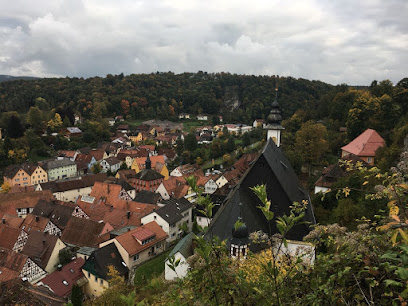
Schloss Oedenberg
Discover the essence of Franconian cuisine at Schloss Oedenberg, where traditional flavors meet a charming beer garden atmosphere.

Brauerei Gasthof Zenglein
Experience authentic Franconian hospitality at Brauerei Gasthof Zenglein, where exceptional beers and traditional cuisine await in Oberaurach.

Essential bars & hidden hideouts
Brauhaus am Kreuzberg
Experience the authentic flavors of Franconia at Brauhaus am Kreuzberg, a charming beer garden in Hallerndorf offering local dishes and brews.

Entlas Cellar Beer Garden
Experience the vibrant atmosphere of Entlas Cellar Beer Garden, where traditional Franconian cuisine meets refreshing local brews in Erlangen.

Schmausenkeller
Discover the vibrant atmosphere of Schmausenkeller, a Franconian beer garden offering traditional German cuisine and local brews in a picturesque setting.

Löwenbräukeller Buttenheim
Discover the flavors of Franconian cuisine at Löwenbräukeller Buttenheim, a delightful beer garden and restaurant experience.

Atzelsberger - Gaststätte & Biergarten
Experience the best of Franconian cuisine and local beers at Atzelsberger - a charming beer garden in Marloffstein.

Weissenohe Abbey
Experience the enchanting Weissenohe Abbey, where rich history meets exquisite Franconian cuisine and local brews amidst breathtaking scenery.

Krug Bräu
Experience authentic Bavarian culture at Krug Bräu, a brewpub offering craft beers, local cuisine, and lively dance hall entertainment in Waischenfeld.
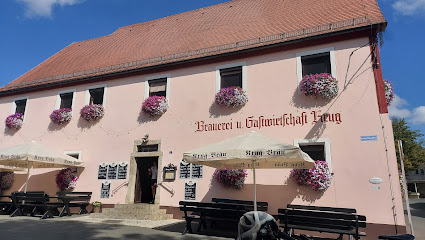
Griess Keller Geisfeld - !! Zufahrt nur über Kellerweg möglich !!
Discover the enchanting Griess Keller Geisfeld, a cozy beer garden in the Franconian countryside, offering local brews and traditional snacks in a scenic setting.
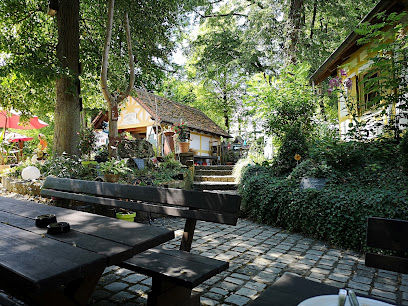
Wiesent-Garten
Experience authentic Franconian flavors and local brews at Wiesent-Garten, a picturesque beer garden in Ebermannstadt.

Kuchenmühle
Discover the charm of Kuchenmühle, a Bavarian beer garden offering delicious Franconian cuisine and a perfect retreat in Wiesenttal.
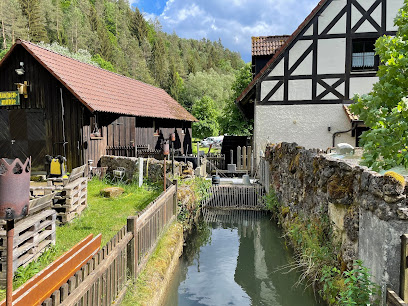
Friedmanns Bräustüberl – Wirtshaus & Biergarten in Gräfenberg
Discover the essence of Franconian culture with traditional cuisine and local brews at Friedmanns Bräustüberl in Gräfenberg.

Araunerskeller Weißenburg
Experience authentic Franconian cuisine and a welcoming beer garden atmosphere at Araunerskeller in Weißenburg.
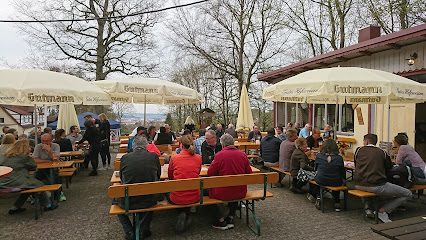
Schweizer Keller
Experience the best of Franconian cuisine at Schweizer Keller, a family-friendly gem in Forchheim offering delicious German dishes and a charming beer garden.

Brauereigaststätte Eichhorn
Experience the authentic taste of Franconia at Brauereigaststätte Eichhorn, a premier brewpub in Forchheim known for its local beers and hearty cuisine.

Brauereigaststätte Hebendanz
Discover the heart of Bavarian culture at Brauereigaststätte Hebendanz, a brewpub serving authentic food and craft beers in Forchheim.
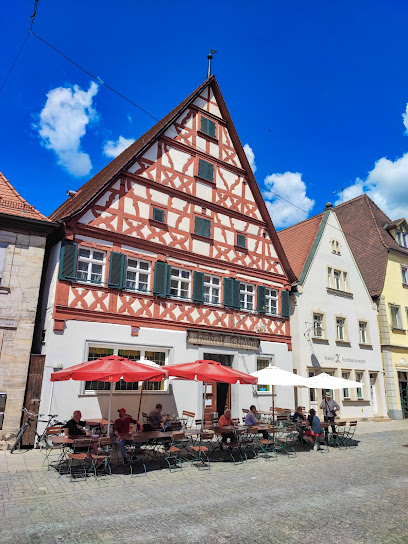
Local Phrases about Franconian Switzerland
-
- HelloGrüß Gott
[grooss got] - GoodbyeAuf Wiedersehen
[owf vee-der-zay-en] - YesJa
[yah] - NoNein
[nine] - Please/You're welcomeBitte
[bit-teh] - Thank youDanke
[dahn-keh] - Excuse me/SorryEntschuldigung
[ent-shool-dee-goong] - How are you?Wie geht's?
[vee gates] - Fine. And you?Gut. Und dir?
[goot oont deer] - Do you speak English?Sprechen Sie Englisch?
[shpre-khen zee ang-lish] - I don't understandIch verstehe nicht
[eekh fair-shtay-eh nikht]
- HelloGrüß Gott
-
- I'd like to see the menu, pleaseIch hätte gerne die Speisekarte, bitte
[eekh hat-teh gair-neh dee shpai-zeh-kahr-teh, bit-teh] - I don't eat meatIch esse kein Fleisch
[eekh ehs-seh kine flysh] - Cheers!Prost!
[prohst] - I would like to pay, pleaseIch möchte bitte zahlen
[eekh mehrk-teh bit-teh tsah-len]
- I'd like to see the menu, pleaseIch hätte gerne die Speisekarte, bitte
-
- Help!Hilfe!
[hill-fuh] - Go away!Geh weg!
[geh vekh] - Call the Police!Rufen Sie die Polizei!
[roo-fen zee dee poh-lee-tsay] - Call a doctor!Rufen Sie einen Arzt!
[roo-fen zee eye-nen ahrts] - I'm lostIch habe mich verirrt
[eekh hah-beh meekh fair-eert] - I'm illMir ist schlecht
[meer ist shlehkt]
- Help!Hilfe!
-
- I'd like to buy...Ich möchte kaufen...
[eekh mehrk-teh kow-fen] - I'm just lookingIch schaue nur
[eekh show-eh noor] - How much is it?Wie viel kostet es?
[vee feel kaws-teht es] - That's too expensiveDas ist zu teuer
[dahs ist tsoy toy-er] - Can you lower the price?Kannst du den Preis senken?
[kahnst doo den prees zehn-ken]
- I'd like to buy...Ich möchte kaufen...
-
- What time is it?Wie spät ist es?
[vee shpayt ist es] - It's one o'clockEs ist ein Uhr
[es ist ighn oor] - Half past (10)Halb elf
[halb elf] - MorningMorgen
[mohr-ghen] - AfternoonNachmittag
[nahk-mee-tahk] - EveningAbend
[ah-bent] - YesterdayGestern
[geh-stern] - TodayHeute
[hoy-teh] - TomorrowMorgen
[mohr-ghen] - 1Eins
[ighns] - 2Zwei
[tsvigh] - 3Drei
[dry] - 4Vier
[feer] - 5Fünf
[foonf] - 6Sechs
[zeks] - 7Sieben
[zee-ben] - 8Acht
[ahkt] - 9Neun
[noyn] - 10Zehn
[tsayn]
- What time is it?Wie spät ist es?
-
- Where's a/the...?Wo ist ein/der...?
[vo ist ighn/dehr] - What's the address?Was ist die Adresse?
[vahs ist dee ah-dreh-suh] - Can you show me (on the map)?Können Sie mir das zeigen (auf der Karte)?
[kern-en zee meer dahs tseeg-en (ouf dehr kar-teh)] - When's the next (bus)?Wann kommt der nächste (Bus)?
[vahn kohmt dehr nekhs-teh (boos)] - A ticket (to ....)Eine Fahrkarte (nach ....)
[igh-nuh fair-kahr-teh (nakh)]
- Where's a/the...?Wo ist ein/der...?
History of Franconian Switzerland
-
Franconian Switzerland, or Fränkische Schweiz, traces its origins back to medieval times. The region's rugged terrain and dense forests made it a natural fortress. Castles such as Rabenstein and Gößweinstein were built to defend against invaders and control trade routes. These fortifications played crucial roles in the region's defense and governance during the Middle Ages.
-
In the early 19th century, Franconian Switzerland became a favorite destination for Romantic poets and painters. Inspired by the area's dramatic landscapes, artists like Carl Spitzweg and Ludwig Richter captured its beauty in their works. This period marked the beginning of Franconian Switzerland's transformation into a popular tourist destination, celebrated for its picturesque scenery and quaint villages.
-
The late 19th and early 20th centuries saw significant developments in the tourism infrastructure of Franconian Switzerland. The construction of railways and roads made the region more accessible to visitors. Pioneering hoteliers and restaurateurs established inns and eateries, catering to the influx of tourists eager to explore the natural beauty and historical sites.
-
Franconian Switzerland, like much of Germany, was not untouched by the devastations of World War II. The region saw various military activities, and some areas were heavily bombed. Post-war, the region faced the challenge of rebuilding its infrastructure and reviving its tourism industry, which had suffered significantly during the conflict.
-
The cultural heritage of Franconian Switzerland is rich and diverse. Traditional Franconian festivals, such as the Bamberg Sandkerwa and the Forchheim Annafest, are celebrated with fervor, showcasing local music, dance, and culinary delights. The region is also known for its craft beer, with numerous small breweries maintaining centuries-old brewing traditions.
-
Franconian Switzerland is renowned for its unique geological formations, including limestone cliffs, caves, and rock towers. The region's natural beauty has led to concerted conservation efforts to preserve its landscapes and biodiversity. The Franconian Switzerland-Veldenstein Forest Nature Park, established in 1995, plays a crucial role in protecting the area's flora and fauna while promoting sustainable tourism.
Franconian Switzerland Essentials
-
Franconian Switzerland, also known as Fränkische Schweiz, is located in northern Bavaria, Germany. The nearest major city is Nuremberg, which is about 50 kilometers away. Nuremberg Airport (NUE) is the closest international airport. From Nuremberg, you can take a train to Forchheim, Ebermannstadt, or Pegnitz, which are key towns in Franconian Switzerland. Alternatively, you can rent a car and drive via the A73 and B470 highways for a scenic route.
-
Franconian Switzerland is best explored by car, as many of the picturesque villages and natural attractions are spread out across the region. However, public transportation options such as buses and trains also connect major towns like Forchheim, Ebermannstadt, and Pottenstein. Bicycles are a popular mode of transport for locals and tourists alike, offering an eco-friendly way to explore the countryside.
-
The official currency in Germany is the Euro (EUR). Credit and debit cards are widely accepted in hotels, restaurants, and larger shops. However, it is advisable to carry some cash, especially when visiting smaller villages or local markets. ATMs are available in most towns, and you can withdraw cash using international bank cards.
-
Franconian Switzerland is generally a very safe destination for tourists. Crime rates are low, and violent crimes are rare. However, it is always wise to take standard precautions such as keeping an eye on your belongings and avoiding isolated areas at night. There are no specific high-crime areas targeting tourists, but staying vigilant is always a good practice.
-
In case of an emergency, dial 112 for immediate assistance from police, fire, or medical services. Most towns have local police stations and medical facilities. It is recommended to have travel insurance that covers medical emergencies. Pharmacies are available in the towns for minor health issues where you can purchase over-the-counter medications.
-
Fashion: Do dress comfortably and appropriately for outdoor activities. Avoid overly casual or revealing clothing when visiting religious sites. Religion: Do respect local customs, especially when visiting churches or chapels. Public Transport: Do be punctual, as German public transport is known for its timeliness. Don't speak loudly or disturb other passengers. Greetings: Do greet people with a firm handshake and maintain eye contact. A polite 'Guten Tag' (Good day) is appreciated. Eating & Drinking: Do try local specialties like Franconian sausages and beer. Don't tip excessively; rounding up to the nearest euro or leaving around 10% is customary.
-
To experience Franconian Switzerland like a local, visit the regional markets where you can buy fresh produce, local cheeses, and traditional crafts. Participate in local festivals such as the Franconian Wine Festival or the Easter Markets. Take a hike through the stunning rock formations and caves, or visit one of the many castles and ruins that dot the landscape. Engaging with locals can provide deeper insights into the area's culture and history.
Nearby Cities to Franconian Switzerland
-
Things To Do in Rothenburg ob der Tauber
-
Things To Do in Wurzburg
-
Things To Do in Erfurt
-
Things To Do in Karlovy Vary
-
Things To Do in Plzeň
-
Things To Do in Stuttgart
-
Things To Do in Frankfurt
-
Things To Do in Heidelberg
-
Things To Do in Munich
-
Things To Do in Leipzig
-
Things To Do in Dresden
-
Things To Do in Prague
-
Things To Do in Český Krumlov
-
Things To Do in Koblenz
-
Things To Do in Salzburg










